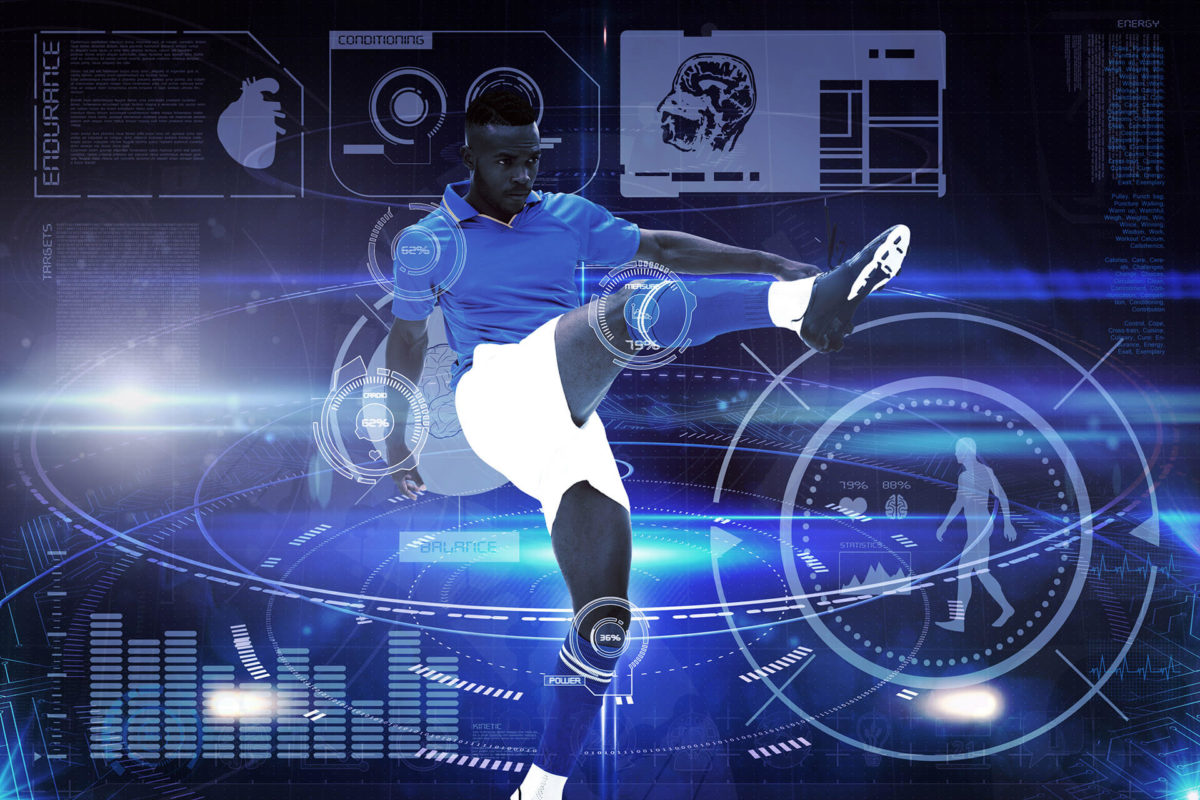For a long time a football match has been considered impossible to model or predict due to the high amount of variables that come into play: There are 22 players on the field, 3 referees, coaching and training staff, fans, numerous amounts of formations and tactics, emotions, luck and randomness (Evans, 2019). However the amount of money that has been attracted by the football industry has increased the professionalization of clubs, creating a vast ecosystem (Dörr, 2019). With this ecosystem growth, data analytics has become an emerging asset in the sport with more and more teams successfully making use of advanced technologies. Areas impacted the most through sport analytics are training, injury prevention, match-analysisand scouting.
Through wearables such as the Catapult Sports’ vest, up to 1.000 data points per second can be collected of a player during training. Every shot, sprint, dribble, pass or challenge is being recorded and analyzed (Evans, 2019). This training data can be combined with the tracking of a players sleep and nutrition routines, to establish personalized training sessions for each player. Not only can the use of data collection during training improve a player’s performance, but it can also be used to forecast injuryrisks. GPS devices collect body movement and metabolic data during training (Dörr, 2019). This data can then be combined with historic injury data of the player and an evaluation can be made if the training intensity for the specific player should be in- or decreased. The data documented through these multiple wearables is stored on cloud-based platforms and can be accessed by any important stakeholder (e. g. coaching and training staff) independent of place and time (Evans, 2019).
Data analysis not only helps to increase the performance of players on the training pitch but also impact how matchesthemselves can be analyzedand prepared for. Machine-learning algorithms are collecting data in order to learn and predict how a certain team responds to different scenarios (Thompson, 2019). Such techniques are called “ghosting” and enable a coaching staff to predict and identify scenarios in which the opponent might be extremely vulnerable for a certain time window (Burn-Murdoch, 2018). In preparation for the match, this information can then be combined with the training data of the player to specifically prepare for these scenarios. Ghosting techniques are also valuable in the field of talent scouting. Playing styles and the potential player fit into the team to ensure overall compatibility can all be assessed through this data (Burn-Murdoch, 2018). Besides from ghosting, the creation of various scouting platforms collecting vast amount of statistics, visualizations and videos about players facilitates the process of finding undervalued and/or high potential players (Dörr, 2019).
These few examples are a testament to the fact that sport analytics is becoming progressively important in the world of football and we are already seeing clubs like Liverpool FC and Manchester City reaping the fruits of this technology emergence. In the future having a competitive advantage will not only depend on the skills and performance of players and coaches, but also on the data-gathering, how this data can be stored and transformed into valuable information and on having the ability to interpret these insights correctly.
References
Burn-Murdoch, J., 2018. How data analysis helps football clubs make better signings. Financial Times. Available at: https://www.ft.com/content/84aa8b5e-c1a9-11e8-84cd-9e601db069b8 [Accessed October 6, 2019].
Dörr, A., 2019. How data analytics is fast becoming football’s must-have signing. Exasol. Available at: https://www.exasol.com/en/blog/how-data-analytics-is-fast-becoming-footballs-must-have-signing/ [Accessed October 6, 2019].
Evans, D., 2019. Big Data Analytics And The Future of Football. Intel. Available at: https://www.intel.co.uk/content/www/uk/en/it-management/cloud-analytic-hub/data-powered-football.html [Accessed October 6, 2019].
Thompson, M., 2018. Statistical modelling, artificial intelligence and particle physics: What will football of the future look like? The Set Pieces. Available at: https://thesetpieces.com/features/statistical-modelling-artificial-intelligence-and-particle-physics-what-does-the-future-of-football-hold/ [Accessed October 6, 2019].


Hi Hans Philip,
Thank you very much for your post giving insights about how data analytics are used in football and how they change the game. While reading through your post, I remembered an insightful article about data analytics in baseball I read in the McKinsey Quarterly called “A view from the front lines of baseball’s data-analytics revolution” (De Smet, Hart, 2018).
Within this article Jeff Luhnow, the general manager of the Houston Astros, describes his perspective on how baseball has changed within the last 30 years. In Luhnow´s opinion, information that is used to make decisions had the highest impact on baseball. While analytics in baseball is associated with Michael Lewis’s Moneyball, Luhnow continues to compare analytics in baseball in 2003 and today. Back then, analytics and information was more about looking at historical performance to predict future performance – while these predictions improved over the years, they still had a large error bar around them, because in baseball, just as you described in football, there are too many variables at play. Nevertheless, technology improved around the ballpark including a better understanding of information about the trajectory of the ball, the physics of the bat swing, and the biomechanics of the pitcher’s delivery. In another McKinsey Quarterly article “How the Houston Astros are winning through advanced analytics” (De Smet, Webb, 2018), Luhnow also gives his perspective on how analytics in baseball might develop in the future; he sees big data combined with AI as the next big thing in baseball and expects that the teams that are able to implement this first will gain a competitive edge over the coming years.
What do you think, will big data paired with AI also be the next big thing in football?
De Smet, A., Hart, J. (2018), A view from the front lines of baseball’s data-analytics revolution, McKinsey Quarterly, Available at: https://www.mckinsey.com/business-functions/organization/our-insights/a-view-from-the-front-lines-of-baseballs-data-analytics-revolution. [Accessed 06-Oct-19]
De Smet, A., Webb, A. (2018), How the Houston Astros are winning through advanced analytics, McKinsey Quarterly, Available at: https://www.mckinsey.com/business-functions/organization/our-insights/how-the-houston-astros-are-winning-through-advanced-analytics. [Accessed 06-Oct-19]